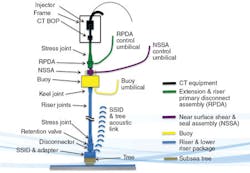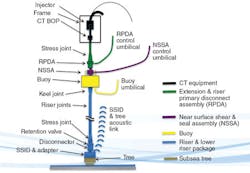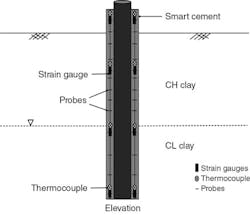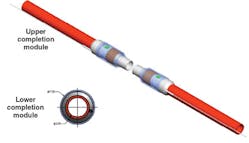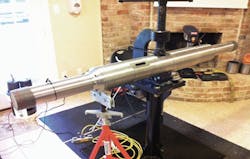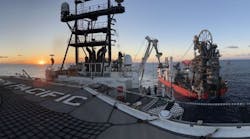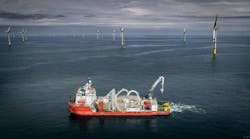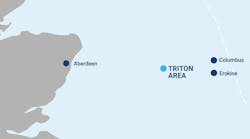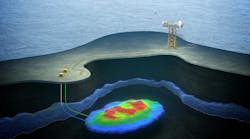Ten key R&D projects highlighted
Roy Long
National Energy Technology Laboratory
James Pappas
Research Partnership to Secure Energy for America
TheResearch Partnership to Secure Energy for America (RPSEA) was formed, with funding and participation from the US Department of Energy, operators, and academia, to develop technologies to sustain oil and gas production in ultra-deepwaters from unconventional reserves and for the country’s small producers. The Ultra-Deepwater (UDW) Program element consisted of 73 research and development projects. The discussion below will address the accomplishments of 10 of those projects.
The objectives of the “Composite Riser for Ultra-Deepwater High-Pressure Wells” project, 07121-1401-01, included a complete basis of design study and analysis, as well as the fabrication and proof of concept testing, of full-diameter, length-scaled drilling riser joints. The project designed and tested a carbon fiber-overwrapped, 1-in.-thick steel drilling riser pipe to produce a 20-in. inner diameter (ID) x 15,000 psi (1,034 bar) working pressure for 10,000-ft (3,048-m) water depths. During technical planning meetings, it was determined that the maximum expected temperature would be no greater than 180°F (82°C), an outer diameter (OD, with buoyancy) based on a 60-in. rotary will be used, and that a 19.5-in. drift diameter riser design will be used for the project. This work confirmed preceding studies suggesting a potential weight savings of 40% to 50% in comparison to all-steel construction. Full-diameter prototypes demonstrated manufacturability and sufficient margins of safety with respect to burst strength, fatigue, and tolerance to impact damage. An American Petroleum Institute (API) technical readiness level (TRL) 3 was achieved.
The primary objective of the “Coil Tubing Drilling and Intervention System Using Cost Effective Vessel” project, 08121-1502-01, was to provide the basis for detailed design of a cost‐effective deepwater coiled tubing (CT) system for downhole work in deepwater Gulf of Mexico satellite wells without the need for a mobile offshore drilling unit (MODU). This work showed the feasibility to facilitate improved resource recovery from existing satellite wells and make it practical to develop reservoirs that would otherwise not meet economic hurdles. Tasks and deliverables included specification of equipment, identification and assessment of hazards and failure modes, and a comprehensive report including a plan and design basis for detailed design in its second phase. This project retained the largest working project group of all UDW investigations.
In the project’s Phase 2, the concept was verified via the issuance of a Certificate of Feasibility for the use of the self-standing riser (SSR) for CT intervention. An extensive set of input data necessary for quantitative dynamic systems analysis was generated, including metocean dynamics, vessel responses, CT loads, and weights. The system properties and numerous performance cases were defined for dynamic analysis. The SSR was simulated and analyzed as a dynamic system for select cases. There are no remaining significant technologies or conceptual gaps. Development still requires due diligence in industry-standard recommended practices for intervention riser systems. The riser (TRL 6) enables a full performance envelope of CT abilities (TRL 2). A successful field test on a deepwater satellite well (not yet performed) could prove that a small vessel can operate CT through an SSR in deepwater; demonstrate improved safety and environmental protection; and incur a cost less than half that of a MODU.
“Advanced Steady-State and Transient, Three-Dimensional, Single and Multiphase, Non-Newtonian Simulation System for Managed Pressure Drilling” project, 08121-2502-01, resulted in the development of a simulation tool that used fully predictive, accurate pressure profiling methods along general well paths by solving mathematical models that do not bear the limitations of ad hoc assumptions implicit in mean hydraulic radius, slot flow, multiphase empirical correlations, and similar approaches. Highly eccentric borehole annuli (with possible washouts, cuttings beds, and fractures) are estimated using custom boundary-conforming curvilinear grids, and the general steady and transient, non-Newtonian flow equations are written to and solved in these special coordinates. Numerical methods are hosted by user-friendly graphical interfaces (with integrated 3D-color capabilities) that support job planning efforts and particularly on-site field use. Elsevier Scientific Publishing published this research, plus practical applications, as a new book, “Managed Pressure Drilling: Modeling, Strategy and Planning” (TRL 6).
In the “Smart Cementing Materials and Drilling Muds for Real Time Monitoring of Deepwater Wellbore Enhancement” project, 10121-4501-01, various technologies were used to develop smart drilling mud and cement slurries with enhanced sensing properties that can be deployed for real-time monitoring during well construction. Smart cement has been designed to monitor the well casing-to-cement bonding over the entire service life of a well. New technologies were developed and integrated to make chemo-thermopiezoresistive cement and drilling muds.
Electrical resistivity of smart cement and smart drilling muds were selected as the sensing properties for the two materials. In this study, small, large, and field models were designed, built, and used to demonstrate real-time monitoring of the flow of smart drilling mud, space fluid, and smart cement and hardening of the cement in place. The effects of various additives, water-to-cement ratios, curing conditions, curing time and temperatures on the piezoresistive behavior of the smart cement and various contaminations on the smart drilling fluids were quantified.
Also curing and piezo-resistive constitutive models were developed to characterize the smart cement behavior. Importantly, change in the resistance of hardened cement in the field well was continuously monitored for more than one year. It was found that pressure in the casing can be predicted from changes in resistivity of smart cement. Another finding was that smart cement can be used to not only determine contamination and stresses in the cement sheath, but also pressure and temperature in the well at different depths. The field test demonstrated a potentially alarming and game-changing observation: The smart cement required more than six months to cure. While this was the result of a single test, the field practice of completing wells, along with perforating casing within hours of primary cementing could be a hazardous practice, and could also lead to poor reservoir isolation with a resultant reduced reservoir performance. While this project accomplished a TRL of 3, much more work is needed on smart materials and fast, stable, and predictable cement curing.
The objectives of the “Analysis of Best Practices for Deepwater Cementing in Oil Based Mud (OBM) and Synthetic Based Mud (SBM)” project, 12121-6503-01, were to develop a fundamental knowledge of oil and synthetic based drilling fluids-cement compatibility issues related specifically to deepwater cementing, quantify risks associated with cementing in OBM/SBM, and develop best practices and recommendations in order to reduce the recognized risks. This study analyzed the relationships between temperature, pressure, cement bond, and the degree of mud removal and its effect on zonal isolation in complex well architectures.
Fluids under laboratory investigation included typical commercially available designs of cement slurries, SBM, OBM, and spacers, with a focus on micro-particulate fluids and other new technologies. Environmental benefits of a successful project should include a decrease in contamination and an improved bonding of cement. Long-term wellbore integrity will be improved and environmental and safety issues such as leaks from the formation and sustained casing pressure will be mitigated, reducing safety risks. OBMs and SBMs allow for much more stable drilling in high-pressure/high-temperature and UDW environments.
However, mud properties that were beneficial for drilling become detrimental to cementing, completions, and well productivity. Fluid incompatibilities resulting from contamination, residue, fluid swapping, and other fluid interactions can result in reduced cement compressive strength, channeling, downhole gelation, and/or a poor cement bond. Incompatibility and incomplete borehole cleaning can result in safety and environmental risks including job failure, future operational issues and loss of zonal isolation.
The work resulted in a guideline manual that operators have begun incorporating into their best practices, is being promoted as tech transfer by the Association of American Drilling Engineers, and has been introduced to the API for incorporation into its cementing recommended practices (TRL 6).
The “Intelligent BOP RAM Actuation Sensor Systems” project, 11121-5503-01, designed, developed, and laboratory tested an instrumented blowout preventer (BOP) ram prototype. In Phase 1, various sensing systems were evaluated, integration approaches were developed, and the integration risks identified and evaluated. A combined electromagnetic (EM) and ultrasonic (UT) multi-sensor system was selected based on its ability to perform pipe diameter measurements. Since both sensing modalities exhibit different sensitivity to the error and noise source, the combined system offers a high degree of robustness in the presence of confounding noise sources.
In Phase 2, a detailed sensing system design was specified for a prototype test system; laboratory test prototypes incorporating the EM and UT sensors and associated electronics, data acquisition and signal processing were built; tests were then conducted, including: pipe position, drilling mud and cuttings attenuation, electromagnetic losses in ferromagnetic metal components and statistical signal variation due to measurement, estimation, and electronics noise. The functional testing for both EM and UT sensors showed that the devised error and noise mitigation approaches are capable of providing robust detection to the presence of tool joints in the vicinity of the sensing system. Limited environmental testing with prototype sensors indicated that survivability across the temperature range of operation, as well as robustness across multiple temperature cycles, was achievable (TRL 3). The TAC deemed this technology ready to proceed to early environmental testing leading to commercialization. The technology in the prototype is designed for new BOP construction, but thus far it appears readily adaptable to existing equipment.
The objective of the “Intelligent Production System for Ultra-Deepwater with Short Hop Wireless Power and Wireless Data Transfer for Lateral Production Control and Optimization” project, 09121-3500-01, was to develop a safe, single system to optimize production for deployment in multilateral wells, which will increase the life of the wells while decreasing production costs. The system would provide remote flow control capabilities inside laterals using an electric, ultra-low power choke system, and would have the capability to collect production data in real time.
The system was developed and lab tested, and is composed of the following new technologies: (1) wireless power transfer (2) wireless communications transfer (3) low power-high stability sensors (4) low power flow control system (5) sensor integration into completion tools (6) an integrated surface command and controls and communication module system. As a result of this work, Shell installed the intelligent system in a fracture stimulation job where four flow control systems with built-in gauges were deployed using a single electrical cable connecting the surface system to the downhole tools. BP Alaska requested a system for a through-tubing wireless application in which gauges are built separate from the flow control tool. These prototypes were further developed and are now fully commercialized products, although they have yet to be mass produced (TRL 6).
The “Reliability of Annular Pressure Buildup (APB) Mitigation Technologies” project, 12121-6502-01, was designed to assess APB risks for numerous typical load cases, evaluate various APB mitigation methods, including novel strategies, and analyze them for effectiveness, and develop recommendations. This project successfully cataloged and analyzed 17 APB mitigation technologies.
It also provided industry with a stochastic tool for analysis, comparison, and possible choices (i.e., ranking) of APB mitigation techniques applicable to specific well and field situations. This newly developed tool was successfully post-tested against several known and reported APB failures and underwent intense scrutiny and review by a panel of more than 35 subject matter experts. An APB Mitigation Techniques Summary Report was prepared as a Society of Petroleum Engineers publication and was forwarded to the API for review. The tool is now being employed by several deepwater operating companies and is expected to gain wider support as others become aware of it (TRL 6).
